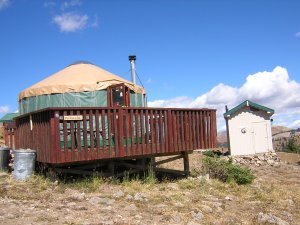| No snowmobiles, please. |
 |  | |
 |  |
The Yurts
Leadville Backcountry YurtsTo provide a more isolated experience, we have limited the number of yurts in the area to two: the Emma Yurt and the Marceline Yurt. Each yurt sleeps five comfortably and is equipped with one double bed and three single bunk beds, a wood stove, firewood and an axe, a propane cooking stove, a propane light, table and chairs, basic cooking utensils and dishes.
 |  | |
 |  |
 |  | |
 |  |
About Yurts
The yurt is a moveable dwelling still in use with some peoples of Central Asia and Africa. Yurts originated with nomadic Mongolian conquerors who, with their horses, overtook the plains of the great Central Asian steppes. When they arrived at a new site, they made yurts with collapsible walls of willow poles, with a door and domed roof covered with felt made from animal wool. Dried grass, animal hair and leather ties were used for lashing parts together.
 |  | |
 |  |
Amazingly sturdy, a good yurt, which was often part of a woman's dowry, could last from 50 to 60 years. In the winter, extra felt was added to the outside for warmth. In the summer, felt sides could be rolled up to admit air. They could be taken apart or put together in under an hour.
Yurts are thought by some to be a derivation of the tipi, preferred by hunting nomads. Pastoral nomads needed more room for their supplies and for tending baby animals, however, and therefore chose yurts as their habitat. Additionally, yurts are better suited for the high winds of the rocky mountain plains because of their domed shape. The word "yurt" comes from a Turkish root word meaning "dwelling."